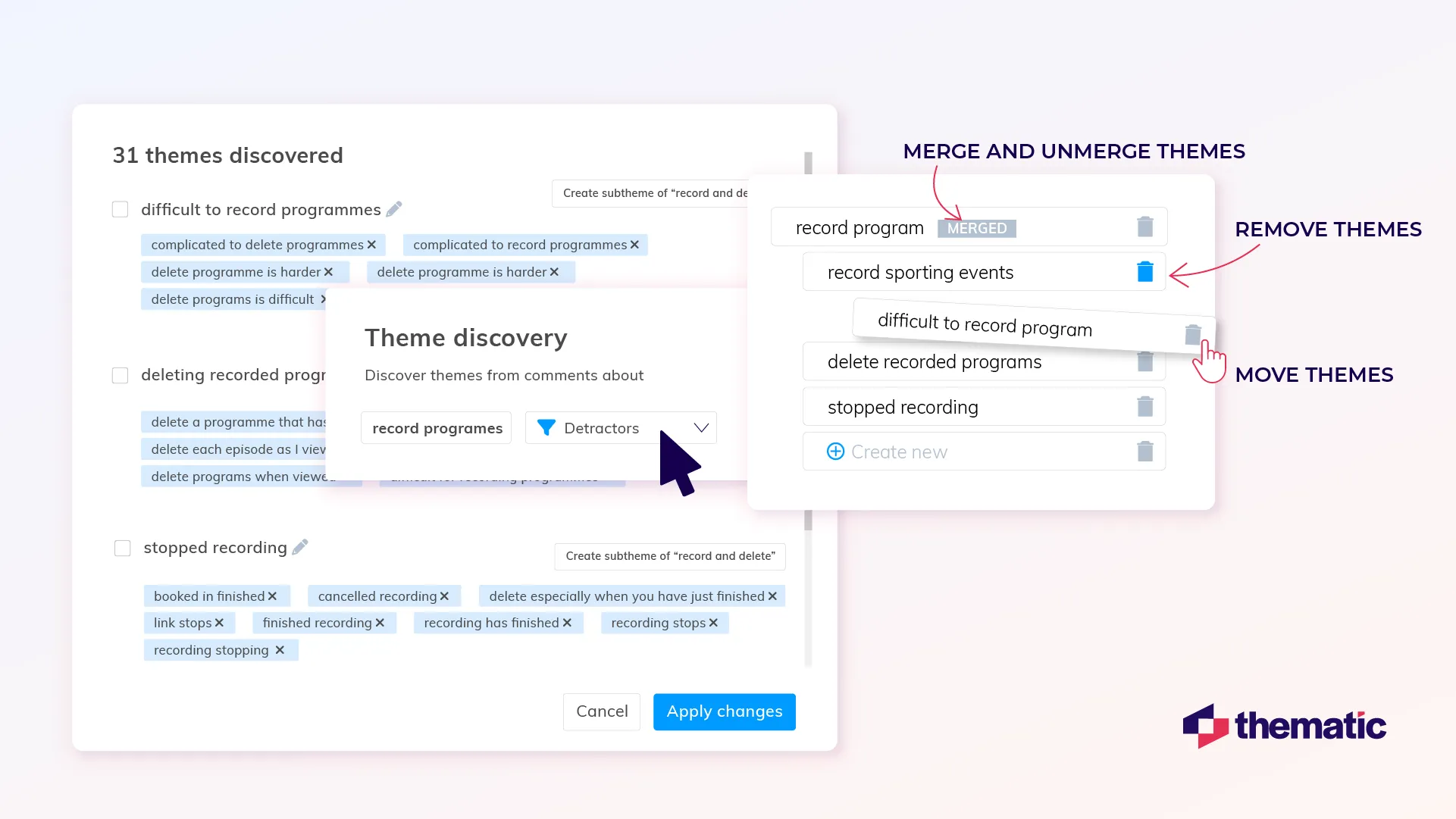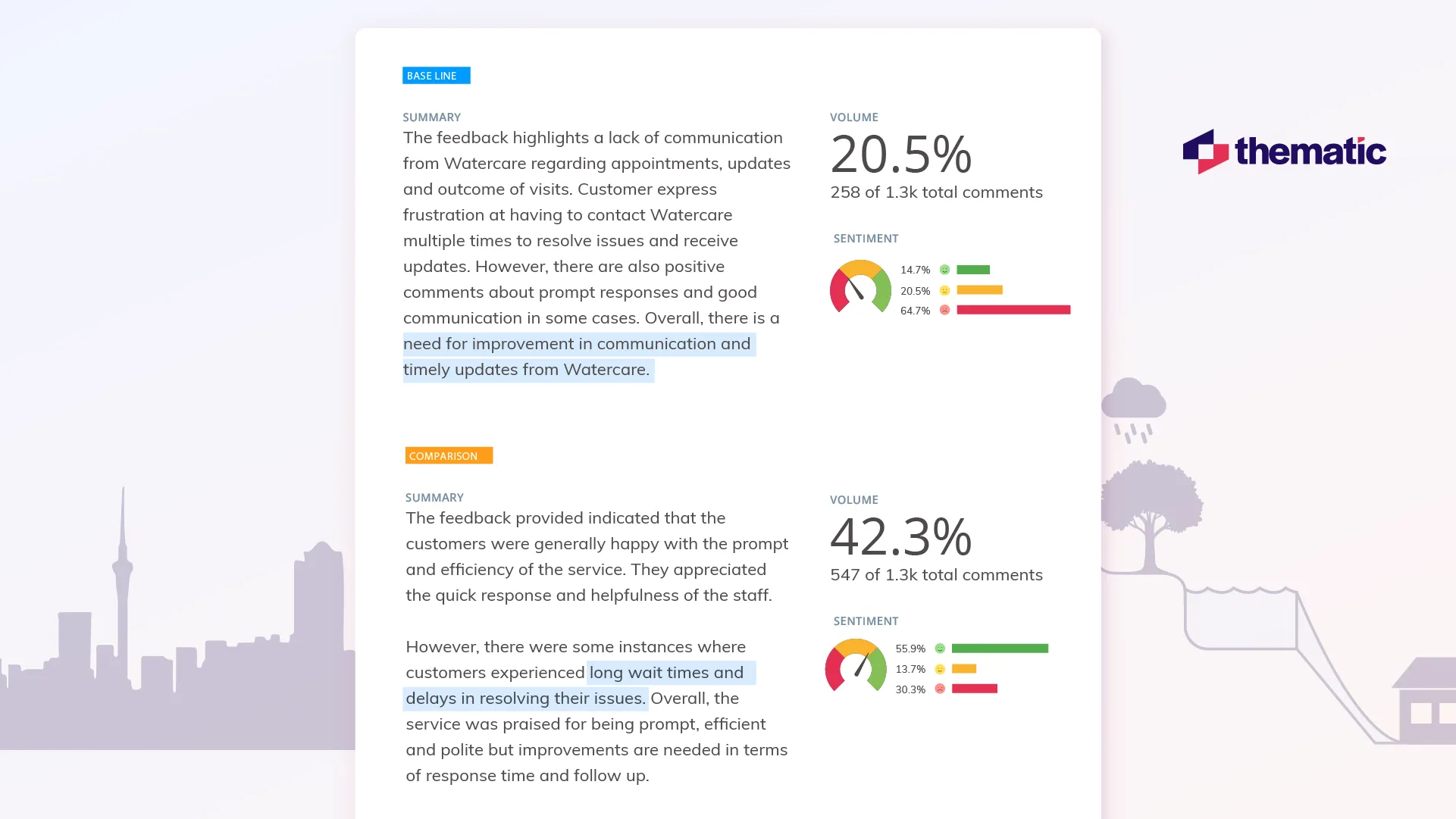
Explore real-world examples of how various industries can use voice of the customer (VOC) insights to improve CX and business performance.

Strip away all the fluff, and your organization's success ultimately hinges on one thing—how well your products and services meet your customers' needs, wants, and desires. But unless you actively seek and listen to what they’re saying and analyze customer behavior, your products and services will likely be out of sync with their evolving expectations.
It doesn’t matter what industry you’re in – customer experience (CX) is a critical component of customer acquisition, retention, and loyalty. However, raw feedback data taken at face value can miss the mark and lead to flawed assumptions about what customers really care about. That means fine-tuning your CX depends on how well you can sift through the noise and meaningfully analyze customer feedback.
Tracking and examining customer conversations over multiple channels takes time and effort – which is why many top-tier brands and leading organizations are turning to AI-driven voice of customer (VoC) tools to extract insights from customer feedback at scale.
This article looks at real-world examples of how various industries can use VoC insights to improve customer experience and business performance.
Voice of the customer (VoC) involves collecting and analyzing customer feedback about their experiences, needs, and preferences regarding your products, services, or brand.
You can collect VoC data through:
This data is crucial for understanding customer satisfaction, identifying areas for improvement, and strengthening customer relationships.
Customer satisfaction is a critical metric, and voice of the customer data plays a significant role in improving it. By collecting and analyzing customer feedback, you can identify areas for improvement and make data-driven decisions to enhance the customer experience. This leads to increased customer satisfaction, loyalty, and retention. When customers feel heard and valued, they’re more likely to remain loyal to your brand and become advocates, contributing to long-term business success.
A typical VoC methodology involves the following steps:
Clearly outline what you aim to achieve with your VoC program, such as improving customer satisfaction or reducing churn.
2. Identify the target audience and customer segments
Determine which customer groups you want to gather feedback from to ensure relevant and actionable insights.
3. Collect customer feedback through various channels
Use surveys, interviews, social media, and other methods to gather comprehensive qualitative feedback from your customers.
4. Analyze and categorize the feedback to identify patterns and trends
Use thematic analysis to uncover common themes and sentiments in the feedback.
5. Prioritize and act on the feedback to improve the customer experience
Focus on the most critical issues and implement changes to address customer concerns and enhance their experience.
6. Measure and track the impact of the VoC program on customer satisfaction and loyalty
Continuously monitor the effectiveness of your VoC initiatives and make adjustments as needed to ensure ongoing improvement.

There are various techniques for capturing customer feedback, which you can leverage to collect comprehensive and actionable customer feedback. Using a VoC tool will help your research teams automatically review and analyze the data – at scale – without straining resources.
Techniques for collecting customer feedback:
The core feature of any user research tool, including voice of the customer, is text analysis. Advanced tools leverage AI, large language models (LLMs), and machine learning to process and analyze large volumes of text data and spot patterns and trends that traditional manual methods can miss.
Theme identification
Thematic’s AI automatically analyzes your feedback to identify key themes and sub-themes in your customer data. This analyis reveals the key topics your customers mention in surveys, online reviews, or support conversations.

Using sentiment and thematic analysis together for analyzing qualitative customer feedback offers a more comprehensive understanding of customer opinions and emotions.
Sentiment analysis provides insights into the overall emotional tone of feedback, whether positive, negative, or neutral, while thematic analysis uncovers the specific topics and themes driving those sentiments. This combination allows you to gauge how your customers feel about your products or services and the reasons behind those feelings.
Read our comprehensive guide for an in-depth sentiment analysis and qualitative data review.
The example below shows how thematic analysis software can break down customer service interactions. Thematic makes it easy to get top-level insights or dive deeper into the data to identify precisely what’s causing the issue.
Insights are only valuable if they are easily shared and accessible by the people who need to use them. Presenting your insights in user-friendly data visualizations or simple dashboards makes it easy to view the top themes in your VoC data, track changes, and understand customer sentiment.
Voice of the customer analysis offers many benefits that help you understand and respond to customer needs:
VoC analysis allows companies to capture direct customer feedback, providing insights into their preferences and pain points. For example, customer interviews provide valuable qualitative insights into individual experiences and preferences. By understanding what customers value, you can tailor their services and products to create a more enjoyable and personalized experience.
When customers feel heard and valued, their satisfaction increases significantly. VoC analysis helps businesses identify what drives customer loyalty and satisfaction, enabling them to implement changes that resonate with their audience. By addressing issues highlighted by customers, companies can build stronger relationships, resulting in a loyal customer base that is less likely to switch to competitors.
Customer churn can be detrimental to any business. VoC analysis provides insights into why customers leave and what factors influence their decision to stay. By addressing concerns and proactively solving problems, companies can implement strategies that reduce churn rates. Understanding the underlying reasons for dissatisfaction helps retain customers, ultimately leading to increased long-term profitability.
VoC analysis provides a constant feedback loop, offering businesses insights that inform product development and innovation. You can develop new features, products, or services that align closely with market demand, keeping offerings relevant and positioning your business as a leader in innovation – which helps attract new customers and retain existing ones.
Traditional market research methods can be time-consuming and costly. VoC analysis streamlines this process by providing real-time feedback from customers. This data is often more relevant and accurate, reflecting current sentiments and trends. By leveraging customer insights, businesses can make informed decisions quickly, saving time and resources while reducing the risk of launching products that do not meet market needs.
Ultimately, all these benefits of Voc analysis culminate in improved revenue performance. Satisfied and loyal customers are more likely to make repeat purchases and recommend the brand to others, leading to increased sales and revenue growth.

Those in retail know full well that customer experience can be the deciding factor between customer loyalty and customer churn. To improve the odds, retail companies can apply apply VoC analysis for various purposes:
Create personalized shopping experiences
Retail companies can use customer feedback, shopping habits, and purchase history to boost engagement through personalized product recommendations. For example, Amazon uses data analytics to suggest products and adjust prices based on what customers are doing online. Meanwhile, Walmart runs detailed surveys to check customer satisfaction, measure its Net Promoter Score (NPS), and make changes based on customers' preferences.
Improve store layout and product offerings
Brick-and-mortar retailers can use VoC to improve their store layout and where they place products. For instance, if customers complain about not finding a specific item, the store can make it easier to access those products. They might also roll out a new line of eco-friendly goods if their target shoppers are into sustainable options. A great example is Starbucks, which has used VoC to design its store layouts, introduce mobile payments, create new drinks, and offer smaller cake portions.
Enhance specific elements of customer experience
VoC analysis can help retail stores make targeted improvements that ensure a more satisfying customer experience. Direct customer feedback can provide actionable insights that help retailers enhance loyalty programs. By rewarding customers with benefits that truly resonate with them, retailers can make them feel valued and more likely to engage. Additionally, analyzing customer preferences can help stores expand their product range in ways that align with what shoppers truly want.

Financial institutions such as commercial banks and insurance companies can use voice of the customer analysis to identify process bottlenecks, gain insight into common frustrations, and design services that match customers’ preferences.
Improve the product development cycle
Financial institutions can tap into customer feedback to create new products and services that fit customers' needs. For instance, a bank might tweak its mobile app features based on user requests. Similarly, insurers can use VoC insights to focus on specific groups, like young professionals, and design plans that suit their lifestyle and budget.
Provide better customer support
Financial services can use VoC to improve their customer support. The customer support team can analyze interactions to identify common issues that, when resolved, will improve the quality of service. For instance, you might set up an automated chat system to manage frequently asked questions, freeing your agents to focus on trickier problems. This cuts down on wait times and improves call routing. Or, if you’re an insurer, you can run surveys to figure out how to make the claims process smoother.
Optimize branch network
Banks can use VoC data, such as the volume of customer complaints about the lack of banking services in a specific location, to optimize their ATM and branch networks.

VoC platforms are well suited for the online shopping environment.
Here are some ways e-commerce companies are leveraging VoC:
Optimize website experience
An online store with clunky navigation makes it tough for visitors to find what they want and actually buy it. That’s why e-commerce companies use VoC to gather feedback and pinpoint annoying UI issues, helping them simplify their website design. By optimizing your online store, you can boost user experience, drive sales, and cut down on cart abandonment.
Personalize product recommendations
Online sellers like Amazon use VoC data to fine-tune their product recommendation algorithms. By analyzing feedback data, online sellers gain a more accurate picture of a customer’s preferences and valuable insights about specific products.
Establish efficient check-out and delivery systems
VoC data can help e-commerce companies identify problem areas in their product delivery process. This allows them to effectively address specific issues by using better tracking systems and partnering with more reliable shipping service providers.
Fine-tune product lines
Customer reviews can uncover recurring product defects or persistent gaps in services. This valuable information can guide e-commerce companies in carrying out product improvement initiatives or deciding which services and products to remove from the shelf or include in their lineup.

Logistics and delivery companies can use voice of the customers insights to identify pain points in their services, such as delivery delays or packaging issues, allowing them to make targeted improvements.
Here are some examples:
Optimize delivery routes
By analyzing customer feedback on delivery routes and schedules, logistics and delivery companies can detect and identify inefficiencies and fix them by optimizing routes and reducing delays. Many companies now provide same-day delivery services wherever possible to meet customer demand.
Refine messaging and customer communication
By analyzing feedback, logistics companies can identify customer pain points and create better communication strategies and solutions for common issues. This helps you manage customer expectations, build trust, and prevent them from jumping ship.
Improve handling and packaging processes
Insights extracted from customer feedback can lead to better packaging solutions. For example, recurring complaints about damaged goods, excessive packaging, and other issues can help you fine-tune your packaging process or adopt more appropriate packaging alternatives for each type of merchandise.
Tackle delivery issues
Many factors that can disrupt getting products from a distribution center to a customer’s doorstep — traffic congestion, parking limitations, and tight delivery schedules. Logistics companies can use customer feedback and real-time data to fine-tune their process, train delivery staff, and improve their coordination with distribution centers and third-party providers.

Prioritizing VoC can help technology companies avoid early failure and gather crucial insights into what new features will meet market demand and improve customer satisfaction.
Align product development with customer needs
Over the years, tech companies have figured out how to use VoC to steer their product development and boost their chances of success. Analyzing customer behavior helps tech companies understand user interactions and preferences, guiding product development. By zeroing in on customer pain points, IT and tech companies can create products and services that are more likely to catch on and make the most of their resources. Take Apple, for example. They’re known for their super user-friendly and innovative products, and they tap into VoC through focus groups, customer surveys, and social media to shape their product design and features.
Improve product features
By collecting and analyzing customer feedback, tech companies can focus on the product features that users love and those that could use some work. This helps you prioritize which features to develop based on what customers really value. It guides product updates and keeps things improving.
Step up customer onboarding and support
VoC data can help tech companies dramatically improve their customer onboarding and support services. By collecting direct feedback, you can identify customer challenges – and develop solutions for each one that make onboarding and support processes smoother for everyone.
Build an innovation culture
Getting in tune with customers is key to staying relevant in the market and finding innovative ways to keep up with their changing needs. With a strong voice of customer strategy, tech companies can better predict future trends and understand how customers will react to the next wave of products and services.

Like retail, the hospitality and entertainment sectors overwhelmingly operate in a customer-centric ecosystem. Customer sentiment is the be-all and end-all of the game, with VoC platforms serving as the primary tool for keeping guests, audiences, and subscribers satisfied, loyal, and fully engaged.
There are many ways hospitality and entertainment companies can leverage VoC:
Deliver customized services
It’s rare for guests and visitors not to feel special with personalized VIP treatment. Those great experiences boost a hospitality brand and encourage people to come back. That’s why hotels, resorts, and similar businesses put a lot of effort into VoC programs to get a clearer picture of how customers feel about their services, amenities, and frontline staff.
Provide personalized recommendations
Entertainment companies like media streaming services collect and analyze customer data to provide highly personalized recommendations based on viewing and listening preferences, browsing history, and online behavior.
Improve amenities and facilities
Hospitality clients pay for amenities, and they hate feeling shortchanged. To keep them happy, businesses must ensure that customers get real value for their money by meeting their core expectations. Customer feedback, surveys, reviews, and comments are great for spotting the must-have facilities and services customers consider essentials. Once those basics are covered, companies can add useful extras and perks that most guests will appreciate. For instance, many hospitality platforms like Airbnb let guests rate their stays and suggest improvements which is a chance to gather information that helps improve app usability and experiences for guests and hosts.
Design effective employee training programs
Customer feedback can guide the development of training programs for frontline staff, too. A good workplace training program should help address service deficiencies and the bucket list of nice-to-haves gleaned from customer feedback, comments, and suggestions.

Case study: Watercare
Watercare is New Zealand’s largest utility company. They set up a voice of customer program to find out what they needed to change after a severe weather crisis put overwhelming pressure on their customer service processes. They used Thematic’s powerful AI analytics software to mine their feedback data for insights.
The organization knew that their customers were getting frustrated by unresolved issues and repair processes in the aftermath of the storms. Using Thematic summaries they realized that customers wanted better updates – and how focusing on this aspect of their customer service would do the most to improve customer satisfaction.
Read the full Watercare and Thematic case study.

Running a business involves many moving parts that all require attention. But customers are the one part you can never over-obsess about.
And, the more satisfied your customers are, the more likely you’ll have a stronger revenue performance.
Everything depends on how well your offerings and processes align with customers’ preferences and behavior. Voice of the customer analysis can help your organization uncover and analyze customer sentiment about your products and processes, providing the clarity you need to tailor and improve the overall customer experience.
Make VoC analytics work for your organization. Try out Thematic on your customer data and see for yourself why so many companies use us for their VoC programs.
Join the newsletter to receive the latest updates in your inbox.